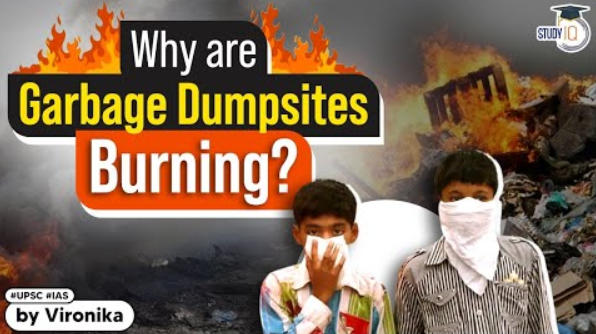Table of Contents
- Indian cities have a new pollution problem this extremely hot summer. The giant garbage dumps the size of multiple football fields from Delhi to Chennai are beginning to burn.
- The Delhi government even imposed a paltry fine of ₹50 lakh on the North Municipal Corporation of Delhi for its negligence.


- At Ghazipur, in 2017-18, there were 31 instances of fires, while there were 18 in 2018-19, and six in 2019-20, in “localised, small areas”, going by data provided by the EDMC in September 2020. The one at Okhla did not report any fires during the same period. At Bhalswa, there were 135 instances in 2017, 100 in 2018, 42 in 2019 and three in 2020, the North MCD told the committee in August 2020.
- Not just in Delhi, such incidents are being reported from several parts of India, including in the Chennai Perungudi dumpsite, not far from the city’s IT corridor.
- On an average, about 2,000 tonnes of wet waste is dumped at the Perungudi landfill on a daily basis.
Landfill vs Dumpsites
- Open dumps are illegal and a person caught dumping in such a way may be fined. Moreover, such dumps have an overall negative impact on the environment. They can also be referred to as an inappropriate manner of waste disposal.
- Due to such dumping, the location becomes a breeding ground for mosquitoes, harboring diseases, inviting animals, and emitting unpleasant odors.
- Landfills can be referred to as a safer and organized system or way of waste management. It is regulated by the Government and must strictly follow certain laws and processing regulations for waste treatment.
- This system was created in the year 1935, in Fresno, California.
What caused the fire?
- The waste that is dumped in landfills is of two types —
- organic (kitchen waste and green waste such as flowers, vegetables, fruits and leaves) and
- inorganic (recyclable waste such as glasses and paper; inert waste such as construction debris, and hazardous and toxic waste like e-waste, and fluorescent tube lights).
- About 70-75 per cent of all waste is organic and can be converted to manure or biogas.
- “Unfortunately, we have a weak management mechanism. That is where the problem is,” said TV Ramachandra, Professor at the Centre for Ecological Sciences, Indian Institute of Science (IISc), Bangalore, adding, “When we dump too much organic material in the landfills, methane will get generated.”
- Methene is produced due to high temperature and pressure. It is inflammable. This along with combustible material such as plastic can lead to fires.
Methane Emission
- A 2021 report by the United Nations Environment Programme shows that most human-caused methane emissions come from just three sectors — fossil fuels, waste, and agriculture.
- It goes on to say that landfills and wastewater make up about 20 per cent of emissions.
- When waste burns, harmful gases are emitted. If you burn plastics, paper and wood, there will be many dioxins, which can be highly toxic and can cause several serious health issues, including cancer. Heavy metals and nitrates can seep into the water and cause kidney failures.
Impact on Environment
- Since open burning of garbage is more common in rural and agricultural areas, there is particular concern for high levels of dioxins and furans settling on crops, in our streams, and in our lakes.
- Dioxins and furans produced by the open burning of garbage are deposited on plants, which are eaten by animals.
- The dioxins and furans are absorbed by these animals and stay in the food chain until they ultimately end up in our meat and dairy products.
- In fact, over 90 percent of our intake of dioxins and furans is from our diet.
Impact on Health
- Open burning of garbage poses health risks to those exposed directly to the smoke. It especially affects people with sensitive respiratory systems, as well as children and the elderly.
- In the short term, exposure to smoke can cause headaches, nausea, and rashes. Over time, it can increase the risk of developing heart disease.

- Some of the pollutants contained in the smoke from open burning of garbage can include:
- Dioxins
- Furans
- Arsenic
- Mercury
- PCBs
- Lead
- Carbon monoxide
- Nitrogen oxides
- Sulphur oxides
- Hydrochloric acid
- One of the greatest concerns with open burning of garbage is the health risks posed by the release of dioxins and furans into the environment. Exposure to dioxins and furans has been linked to:
- Certain types of cancers
- Liver problems
- Impairment of the immune system, the endocrine system, and reproductive functions
- Effects on the developing nervous system and other developmental events
Solutions
- The best way to deal with waste is to segregate it at the source itself — that is in our homes.
- Incentivise segregating at the source. Give the people who segregate at home some monetary benefits because they are lowering the burden.
- Penalise those who don’t. If this is done, management becomes easier and people will also take part in it.
- Decentralised and scientific waste management is needed to ensure that landfills do not grow in size.
- Sanitary landfills — where there is no seepage of wastes into the land or water — are the need of the hour. However, even in these landfills, management is a problem.
- The effective solution could lie in setting up an independent authority to oversee waste management in the country.
- The Solid Waste Management Rules, 2016 detail how waste should be handled, but these rules are rarely followed.
- “Implement the rules in the true spirit, that will solve the problem.”
Question:
Which is the headquarters of United Nations Environment Programme (UNEP)?
[A] Geneva
[B] Nairobi
[C] Paris
[D] New York
Latest Burning Issues | Free PDF































 WhatsApp
WhatsApp